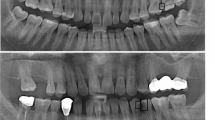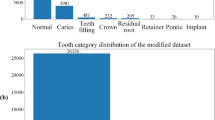Abstract
Dental caries is a common dental disease. According to statistics, about 90% of adults suffer from dental caries. Therefore, early detection and treatment of dental caries are crucial to dental health. According to the depth of carious lesions, dental caries can be classified into shallow, moderate, and deep caries. Among them, the accurate classification of moderate caries and deep caries is important to making the subsequent treatment plan. Clinically, doctors can make the diagnosis with the help of CBCT images. However, due to the spatial complexity of the 3D volume, the difficulty of labeling the carious lesion, and the insignificant difference between moderate and deep caries, there is still a great challenge to accurately identifying moderate and deep caries. And to the best of our knowledge, there is no study on automatic dental caries classification based on CBCT images. In this paper, we propose a feature patch based attention model to improve the classification accuracy of dental caries in CBCT images. We extract overlapping patches from the 3D feature maps and assign every patch with a corresponding weight computed by adaptive learning to achieve automatic screening of regions that are critical for classification. We collect a real-world dental dataset which includes 167 CBCT scans with moderate caries and 157 CBCT scans with deep caries. A series of experiments demonstrate that our algorithm achieves 92% accuracy on caries classification, which outperforms state-of-the-art methods by a large margin.
Access this chapter
Tax calculation will be finalised at checkout
Purchases are for personal use only
Similar content being viewed by others
References
Machiulskiene, V., et al.: Terminology of dental caries and dental caries management: consensus report of a workshop organized by ORCA and cariology research group of IADR. Caries Res. 54(1), 7–14 (2020)
Pitts, N.B., et al.: Dental caries. Nat. Rev. Dis. Primers. 3(1), 1–16 (2017)
Munteanu, A., Holban, A.M., Păuna, M.R., Imre, M., Farcaiu, A.T., Farcaiu, C.: Review of professionally applied fluorides for preventing dental caries in children and adolescents. Appl. Sci. 12(3), 1054 (2022)
Duan, W., Chen, Y., Zhang, Q., Lin, X., Yang, X.: Refined tooth and pulp segmentation using U-Net in CBCT image. Dentomaxillofacial Radiol. 50(6), 20200251 (2021)
Lin, X., et al.: Micro-computed tomography-guided artificial intelligence for pulp cavity and tooth segmentation on cone-beam computed tomography. J. Endodontics 47(12), 1933–1941 (2021)
Yang, X., Chen, Y., Yue, X., Lin, X., Zhang, Q.: Variational synthesis network for generating micro computed tomography from cone beam computed tomography. In: 2021 IEEE International Conference on Bioinformatics and Biomedicine (BIBM), pp. 1611–1614. IEEE (2021)
Lee, J.H., Kim, D.H., Jeong, S.N., Choi, S.H.: Detection and diagnosis of dental caries using a deep learning-based convolutional neural network algorithm. J. Dent. 77, 106–111 (2018)
Cantu, A.G., et al.: Detecting caries lesions of different radiographic extension on bitewings using deep learning. J. Dent. 100, 103425 (2020)
Casalegno, F., et al.: Caries detection with near-infrared transillumination using deep learning. J. Dent. Res. 98(11), 1227–1233 (2019)
Schwendicke, F., Elhennawy, K., Paris, S., Friebertshäuser, P., Krois, J.: Deep learning for caries lesion detection in near-infrared light transillumination images: a pilot study. J. Dent. 92, 103260 (2020)
Moutselos, K., Berdouses, E., Oulis, C., Maglogiannis, I.: Recognizing occlusal caries in dental intraoral images using deep learning. In: 2019 41st Annual International Conference of the IEEE Engineering in Medicine and Biology Society (EMBC), pp. 1617–1620. IEEE (2019)
Liu, L., Xu, J., Huan, Y., Zou, Z., Yeh, S.C., Zheng, L.R.: A smart dental health-IoT platform based on intelligent hardware, deep learning, and mobile terminal. IEEE J. Biomed. Health Inf. 24(3), 898–906 (2019)
He, K., Zhang, X., Ren, S., Sun, J.: Deep residual learning for image recognition. In: Proceedings of the IEEE Conference on Computer Vision and Pattern Recognition, pp. 770–778 (2016)
Xu, X., et al.: A deep learning system to screen novel coronavirus disease 2019 pneumonia. Engineering 6(10), 1122–1129 (2020)
Roth, H.R., et al.: Improving computer-aided detection using convolutional neural networks and random view aggregation. IEEE Trans. Med. Imaging 35(5), 1170–1181 (2015)
Dosovitskiy, A., et al.: An image is worth 16x16 words: transformers for image recognition at scale. In: International Conference on Learning Representations (2020)
Schlemper, J., et al.: Attention gated networks: learning to leverage salient regions in medical images. Med. Image Anal. 53, 197–207 (2019)
Wang, S., Li, L., Zhuang, X.: AttU-Net: attention U-Net for brain tumor segmentation. In: Crimi, A., Bakas, S. (eds.) International MICCAI Brainlesion Workshop. BrainLes 2021, vol. 12963, pp. 302–311. Springer, Cham (2022)
Shen, C., et al.: Attention-guided pancreatic duct segmentation from abdominal CT volumes. In: Oyarzun Laura, C., et al. (eds.) DCL/PPML/LL-COVID19/CLIP -2021. LNCS, vol. 12969, pp. 46–55. Springer, Cham (2021). https://doi.org/10.1007/978-3-030-90874-4_5
Gao, X., Qian, Y., Gao, A.: COVID-VIT: Classification of COVID-19 from CT chest images based on vision transformer models. arXiv preprint arXiv:2107.01682 (2021)
Yuan, K., Guo, S., Liu, Z., Zhou, A., Yu, F., Wu, W.: Incorporating convolution designs into visual transformers. In: Proceedings of the IEEE/CVF International Conference on Computer Vision, pp. 579–588 (2021)
Ilse, M., Tomczak, J., Welling, M.: Attention-based deep multiple instance learning. In: International Conference on Machine Learning, pp. 2127–2136. PMLR (2018)
Cao, Y., Xu, J., Lin, S., Wei, F., Hu, H.: GCNet: non-local networks meet squeeze-excitation networks and beyond. In: Proceedings of the IEEE/CVF International Conference on Computer Vision Workshops (2019)
Acknowledgements
This work was supported by the National Natural Science Foundation of China (No. 62173252, 61976134), the Clinical Research Plan of Shanghai Hospital Development Center (grant no. SHDC2020CR3058B), the Shanghai Municipal Health Commission (grant no. 202040282).
Author information
Authors and Affiliations
Corresponding author
Editor information
Editors and Affiliations
Rights and permissions
Copyright information
© 2023 The Author(s), under exclusive license to Springer Nature Switzerland AG
About this paper
Cite this paper
Ren, G., Chen, Y., Qi, S., Fu, Y., Zhang, Q. (2023). Feature Patch Based Attention Model for Dental Caries Classification. In: Chen, Y., et al. Clinical Image-Based Procedures. CLIP 2022. Lecture Notes in Computer Science, vol 13746. Springer, Cham. https://doi.org/10.1007/978-3-031-23179-7_7
Download citation
DOI: https://doi.org/10.1007/978-3-031-23179-7_7
Published:
Publisher Name: Springer, Cham
Print ISBN: 978-3-031-23178-0
Online ISBN: 978-3-031-23179-7
eBook Packages: Computer ScienceComputer Science (R0)




